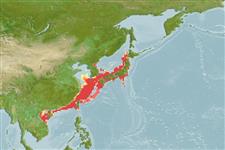Environment: milieu / climate zone / depth range / distribution range
Ecologia
marino; distribuzione batimetrica ? - 200 m (Ref. 11230). Temperate
Northwest Pacific: southern Japan, the East China Sea and around Taiwan.
Size / Peso / Age
Maturity: Lm ? range ? - ? cm
Max length : 15.0 cm TL maschio/sesso non determinato; (Ref. 637)
Spine dorsali (totale): 9 - 10; Raggi dorsali molli (totale): 10; Spine anali 3; Raggi anali molli: 8 - 9; Vertebre: 10 - 15. This species has the following characters: chin with a pair of distinct spines; proximal-middle radial of first anal-fin pterygiophore slender with no hollow; well developed lateral wing; 13 (rarely 12) pectoral-fin rays; A III, 9 (rarely 8); longest anal-fin ray is shorter than half of base of anal fin; body depth 34-41% LS; lateral line scales 48-51; gill rakers 22-24 on lower arm (Ref. 76883). Body uniformly brownish-silver dorsally, white ventrally (Ref. 559).
Feeds on small crustaceans and fishes, among others (Ref. 559). Caught in depths of less than 150 m (Ref. 637).
Life cycle and mating behavior
Maturità | Riproduzione | Deposizione | Uova | Fecundity | Larve
Masuda, H., K. Amaoka, C. Araga, T. Uyeno and T. Yoshino, 1984. The fishes of the Japanese Archipelago. Vol. 1. Tokai University Press, Tokyo, Japan. 437 p. (text). (Ref. 559)
IUCN Red List Status (Ref. 130435)
Threat to humans
Harmless
Human uses
Informazioni ulteriori
Nomi ComuniSinonimiMetabolismoPredatoriEcotossicologiaRiproduzioneMaturitàDeposizioneSpawning aggregationFecundityUovaEgg development
BibliografiaAcquacolturaProfilo di acquacolturaVarietàGeneticaElectrophoresesEreditarietàMalattieElaborazioneNutrientsMass conversion
CollaboratoriImmaginiStamps, Coins Misc.SuoniCiguateraVelocitàModalità di nuotoArea branchialeOtolithsCervelliVista
Strumenti
Special reports
Download XML
Fonti Internet
Estimates based on models
Preferred temperature (Ref.
123201): 11.9 - 22.2, mean 18.5 °C (based on 126 cells).
Phylogenetic diversity index (Ref.
82804): PD
50 = 0.5078 [Uniqueness, from 0.5 = low to 2.0 = high].
Bayesian length-weight: a=0.00479 (0.00182 - 0.01257), b=3.12 (2.89 - 3.35), in cm total length, based on LWR estimates for this (Sub)family-body shape (Ref.
93245).
Trophic level (Ref.
69278): 4.0 ±0.66 se; based on food items.
Fishing Vulnerability (Ref.
59153): Low vulnerability (10 of 100).
